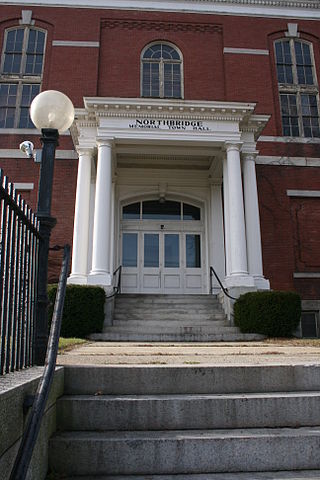
Northbridge is a town in Worcester County, Massachusetts, United States. The population was 16,335 at the 2020 census. The Northbridge Town Hall is located at 7 Main Street in Whitinsville. The town is now a part of the Blackstone River Valley National Heritage Corridor, of the National Park Service. Northbridge claims to history include: Native American Nipmuc lands, Colonel John Spring, who led the Uxbridge militia training company in the American Revolution, Samuel Spring, Revolutionary War Chaplain, the Residence of Ezra T. Benson 1830–1832, the birthplace of President Millard Fillmore's mother, Phoebe, and home to the Whitin Machine Works from 1831 to 1964.

Whitinsville is an unincorporated village within the town of Northbridge in Worcester County, Massachusetts, United States. Whitinsville is a census-designated place (CDP) and its population was 6,750 at the 2020 census. Whitinsville is pronounced as if it were spelled "White-ins-ville". It was founded by the Whitin family, after whom it is also named. It is a post office jurisdiction, with a ZIP Code of 01588. It is located on the Mumford River, a tributary of the Blackstone River.
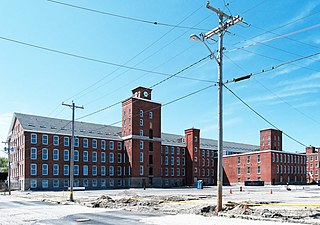
Wamsutta Mills is a former textile manufacturing company and current brand for bedding and other household products. Founded by Thomas Bennett, Jr. on the banks of the Acushnet River in New Bedford, Massachusetts in 1846 and opened in 1848, Wamsutta Mills was named after Wamsutta, the son of a Native American chief who negotiated an early alliance with the English settlers of the Plymouth Colony. It was the first of many textile mills in New Bedford, and gradually led to cotton textile manufacturing overtaking whaling as the town's principal industry by the 1870s.
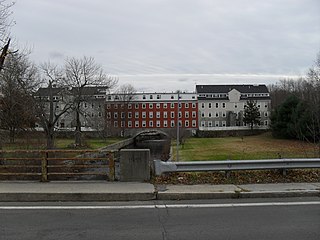
Robert Rogerson was an early American industrialist. He was born in Taunton, Massachusetts, and died in the United States.
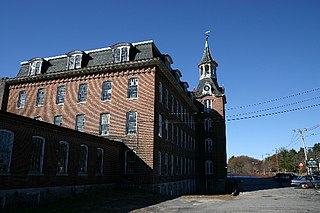
James Fletcher Whitin was the youngest son of Paul Whitin, and brother of John Crane Whitin, who founded the Whitin Machine Works in 1831 at Northbridge, Massachusetts. James Whitin would also enter the family textile business, at a later age. The Whitin Machine Works grew to become one of the largest textile machinery companies in the world.

Linwood is a village with its own post office in the towns of Northbridge and Uxbridge, Massachusetts, United States.
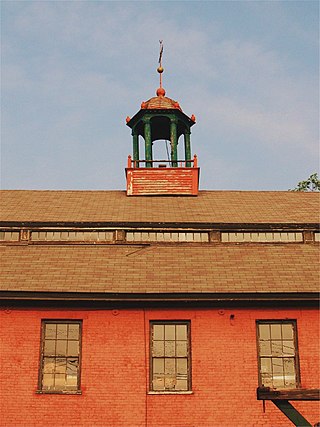
Col. Paul Whitin, (1767–1831) was an American blacksmith and pioneering industrialist who in 1826 Northbridge, Massachusetts established P Whitin and Sons, a new cotton mill with his sons. This company would grow and acquire other mills in the area. In 1831 his son John C Whitin obtained a patent for a mechanized Cotton Picker. Textile machinery would become a larger percentage of their business over time. would later become the largest maker of specialty textile machinery in the world.

North Uxbridge is a village and a post office in the town (township) of Uxbridge in Worcester County, Massachusetts, United States. The postal zip code is 01538. It is classified as a community or populated place located at latitude 42.088 and longitude -71.641 and the elevation is 266 feet (81 m). North Uxbridge appears on the Uxbridge U.S. Geological Survey Map. Worcester County is in the Eastern time zone and observes DST. North Uxbridge is located approximately 36 miles west-southwest of Boston, and 15 miles southeast of Worcester. The town meeting in 1885 set aside North Uxbridge as a "special district", since its population had exceeded 1000 people. North Uxbridge appeared as a separate Census tract in the 1960 census, with a population of 1882. In 2013, an Uxbridge DIY show, The Garage, with Steve Butler, went worldwide from Steve's garage in North Uxbridge.

Rogersons Village Historic District is a historic mill village in Uxbridge, Massachusetts, United States.

Saylesville is a village and historic district in Lincoln, Rhode Island.

The Whitin Machine Works (WMW) was founded by Paul Whitin and his sons in 1831 on the banks of the Mumford River in Northbridge, Massachusetts. The village in this section of Northbridge became known as Whitinsville in 1835, in honor of its founder.

Mill Conversion or mill rehab is a form of adaptive reuse in which a historic mill or industrial factory building is restored or rehabilitated into another use, such as residential housing, retail shops, office, or a mix of these non-industrial elements (mixed-use).

The Rockdale Common Housing District is a historic district at 4–20 McBride, 46–58 Plantation, and 37–42 Taft Sts. in Northbridge, Massachusetts, United States. The district is composed of a collection of tenement houses built from c. 1880 to 1920. They were built by members of the Whitin family, who owned most of the textile production capacity in Northbridge. The district was added to the National Register of Historic Places in 1983.

The Whitinsville Historic District is a historic district on Church, East, Fletcher, Hill, Woodland, Lake, and Water Sts., Castle Hill Rs., and Linwood Avenue in Northbridge, Massachusetts. The district encompasses the historic 19th century mill village of Whitinsville, which grew up around an 1826 brick mill building erected by Paul Whitin. The Whitin family came to dominate the textile trade in Northbridge, with numerous mill complexes.

The Ipswich Mills Historic District encompasses a major textile mill complex and associated worker housing along the Ipswich River near the center of Ipswich, Massachusetts. The district includes the factories of the Ipswich Mill Company, and several blocks of modest worker cottages mostly on side streets off Estes and Kimball Streets. The site had been used as for mills since the 17th century, and was purchased by the Ipswich Mill Company in 1868. Mill worker housing was built surrounding the complex through the early 20th century, when River Court, Peatfield Street, and 1st through 6th Streets were laid out. The district was listed on the National Register of Historic Places in 1996.
Wild's Mill Complex was among the last remaining industrial buildings in the formerly thriving milling community of Valatie, Columbia County, New York, United States. It was located southeast of the intersection between U.S. Route 9 and State Route 203. A five-story brick structure, it served as an historical landmark and its 5.5 acres (2.2 ha) lot contained the ruins of a previous mill. It was situated along the west bank of the Kinderhook Creek.

The Jaffrey Mills is a historic mill complex at 41 Main Street, in the central business district of Jaffrey, New Hampshire. It consists of a connected series of primarily brick buildings flanking the Contoocook River just north of Main Street. Its oldest buildings, the original mill and office building, are on the west side of the river. They were built in 1868, and feature mansard roofs and banded dentil brick cornices. The mill building has a tower that originally sported a cupola, but this was removed early in the 20th century. In 1872 the building on the east side was built, and the two sides joined by timber-frame bridges were added in 1897, at the same time the east building was extended northward. Later additions to the north of the east building include a storage area and a loading dock. The mill complex, the only 19th-century industrial complex of its type to be built in Jaffrey, was listed on the National Register of Historic Places in 1982. It has been converted into residences.
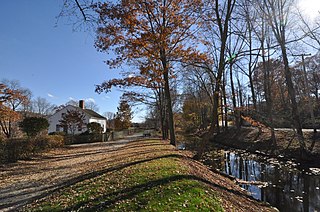
Blackstone River Valley National Historical Park is a National Park Service unit in the states of Rhode Island and Massachusetts. The park was created for the purpose of preserving, protecting, and interpreting the industrial heritage of the Blackstone River Valley and the urban, rural, and agricultural landscape of that region. The Blackstone River Valley was the site of some of the earliest successful textile mills in the United States, and these mills contributed significantly to the earliest American Industrial Revolution. The subsequent construction of the Blackstone Canal, a few years after the successful completion of the Erie Canal, helped to sustain the region's industrial strength.

The Coleman-Franklin-Cannon Mill is a historic industrial complex at 625 Main Street SW in Concord, North Carolina. The recognized complex consists of ten buildings on 6.6 acres (2.7 ha), about 2 miles (3.2 km) west of downtown Concord. Another 4.4 acres are not included. The oldest portion of the mill, now its eastern section, is a brick two-story structure 14 bays long and 9 deep. The historic site also includes some worker housing.
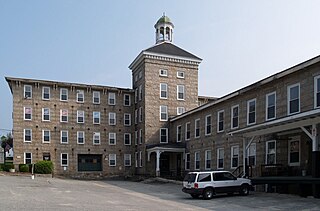
The Manchaug Village Historic District is a historic district encompassing the 19th century industrial village center of Manchaug in Sutton, Massachusetts. Developed in the 1820s around textile mills on the Mumford River, it was the largest industrial area in Sutton, with at least three mill complexes in operation. The district is centered on the junction of Main Street with Manchaug, Putnam Hill, and Whitins Roads.



















